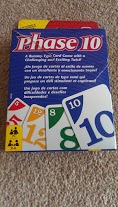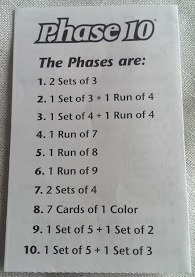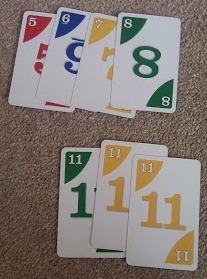Phase 10 might be an odd choice for a gaming website to review - after all, it's a simple card game that can be found in many high street stores, for under £10.
However, it gets quite a few plays in our house, and apparently is the second best-selling commercial card-game behind Uno. So, let's take a look and decide if it's something that might be enjoyed by your family.
My sister actually introduced me to Phase 10, and it's a game her family enjoys a lot. My wife then bought a copy and we've played it quite a few times since. However, it's fair to say that it's not exactly well loved on the Geek (where it's currently ranked just inside the top 10,000 games.
I decided to cast a critical eye over the game and let you know what I think.
I decided to cast a critical eye over the game and let you know what I think.
How to Play

If you look closely you can see that the box has been ripped - that goes to show how much play the game sees in our house (and is also good evidence that you should be careful what you leave lying around in reach of a 1 year old....)
The game consists of 108 cards; 24 each of the four colours (red, yellow, blue and green in my version), numbered 1-12, as well as four 'skip' cards and eight 'wild' cards. Add in a simple rules sheet, and some player aids, and that's the component list done!
The game consists of 108 cards; 24 each of the four colours (red, yellow, blue and green in my version), numbered 1-12, as well as four 'skip' cards and eight 'wild' cards. Add in a simple rules sheet, and some player aids, and that's the component list done!

Phase 10 is a Rummy variant - more specifically it falls into the family of Contract Rummy. Like most rummy games, it involves keeping score, so a paper and pen are also useful to have to hand.

At the beginning of each round, each player is dealt 10 cards. Like most Rummy games, the object of the game is to get rid of all your cards, usually by playing sets, or runs. However, the colours of the cards are, most of the time, irrelevant.
Why most of the time?
Well, that leads us to talk about why the game is called Phase 10....
Why most of the time?
Well, that leads us to talk about why the game is called Phase 10....

Each player starts the game at Phase 1. If they manage to complete that Phase before one player gets rid of all their cards then in the next round they proceed to the next Phase. Therefore during the game players can be on different phases, and be trying to achieve different goals, which makes it a bit different to 'standard' Rummy.
Game play is just like Rummy - on your turn you draw a card, play a card(s) to the table and then discard a card. When one player has got rid of all their cards the round ends.
Scoring is as follows;
- each special card (skip or wild) is worth 15 points.
- each number card 10 or higher is worth 10 points.
- each number card less than 10 is worth 5 points.
Game play is just like Rummy - on your turn you draw a card, play a card(s) to the table and then discard a card. When one player has got rid of all their cards the round ends.
Scoring is as follows;
- each special card (skip or wild) is worth 15 points.
- each number card 10 or higher is worth 10 points.
- each number card less than 10 is worth 5 points.

As an example, I've taken the hand above, and shown how it can be used to complete the second phase.
As you can see, the player has played a run of four, and a set of three, thereby fulfilling the requirements of the phase. Also as you can see, the colours of the cards are irrelevant - in fact, the only time the colours come into play is phase 8, where you need 7 cards of one colour.
You an also see that the player would have the following cards left in hand; red 2, a skip and a wild. If this was a real game the wild could have been played with either the set or the run, the skip could be discarded, which would end this players turn, and the next player would miss their turn!
The winner of the game is the player with the lowest score after at least one player has completed Phase 10.
As you can see, the player has played a run of four, and a set of three, thereby fulfilling the requirements of the phase. Also as you can see, the colours of the cards are irrelevant - in fact, the only time the colours come into play is phase 8, where you need 7 cards of one colour.
You an also see that the player would have the following cards left in hand; red 2, a skip and a wild. If this was a real game the wild could have been played with either the set or the run, the skip could be discarded, which would end this players turn, and the next player would miss their turn!
The winner of the game is the player with the lowest score after at least one player has completed Phase 10.
Review
I'm not a big fan of Rummy - my issue with these sorts of games is that they rely a lot on luck of the draw. If I were to chose, as a gamer, to play a Rummy variant I would play Rummikub, as I enjoy the board manipulation - I find that it allows a player of greater skill to do better at the game. Now, there will probably be people screaming at their computers now "Rummy has loads of skill!!"; you might be right, but I just don't find it engaging enough. Those decision making points and the puzzle aspect of Rummikub I find far more appealing.
So that means I'm not a fan of Phase 10 then - right?
Well, actually, I do quite enjoy this game. Sure, it still has the luck of the draw aspect, but the rounds play quickly, and the different phases make it a bit more interesting. Although the game play doesn't change, the fact the goal is changing keeps it a bit more interesting.
But if you're reading this, you don't really care what my opinion as a gamer is, you want to know how it plays in a family setting.
My 6 year old enjoys Phase 10, although it's not his favourite game and he doesn't ask for it all the time. He still needs a little help playing his cards, because he has a tendency to lock himself into a way of thinking and then not see other options. For instance, if he needs to sets of 3, he might have 2 4's and 2 6's and he has a wild card. He already decides that wild will be a 6, and if he draws another 6 he might not realise he can move the wild to the 4's so he has the 2 sets he needs.
Other than that though, he doesn't need any help to play, and in a recent game we played, we didn't keep score and we both completed Phase 10 at the same time. So he's definitely able to be competitive!
Summary
A nice, simple, inexpensive card game, that won't make your gaming group table, but should see enough play at your family table to earn it's price.
I'm not a big fan of Rummy - my issue with these sorts of games is that they rely a lot on luck of the draw. If I were to chose, as a gamer, to play a Rummy variant I would play Rummikub, as I enjoy the board manipulation - I find that it allows a player of greater skill to do better at the game. Now, there will probably be people screaming at their computers now "Rummy has loads of skill!!"; you might be right, but I just don't find it engaging enough. Those decision making points and the puzzle aspect of Rummikub I find far more appealing.
So that means I'm not a fan of Phase 10 then - right?
Well, actually, I do quite enjoy this game. Sure, it still has the luck of the draw aspect, but the rounds play quickly, and the different phases make it a bit more interesting. Although the game play doesn't change, the fact the goal is changing keeps it a bit more interesting.
But if you're reading this, you don't really care what my opinion as a gamer is, you want to know how it plays in a family setting.
My 6 year old enjoys Phase 10, although it's not his favourite game and he doesn't ask for it all the time. He still needs a little help playing his cards, because he has a tendency to lock himself into a way of thinking and then not see other options. For instance, if he needs to sets of 3, he might have 2 4's and 2 6's and he has a wild card. He already decides that wild will be a 6, and if he draws another 6 he might not realise he can move the wild to the 4's so he has the 2 sets he needs.
Other than that though, he doesn't need any help to play, and in a recent game we played, we didn't keep score and we both completed Phase 10 at the same time. So he's definitely able to be competitive!
Summary
A nice, simple, inexpensive card game, that won't make your gaming group table, but should see enough play at your family table to earn it's price.

No comments:
Post a Comment